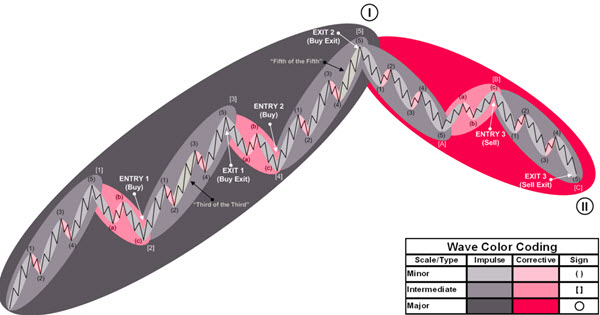The Elliot Wave Theory epitomizes the basic principle behind technical analysis, namely that patterns can be detected in past statistical data that you can use to find trading opportunities in the present. According to its creator, Ralph Nelson Elliott, the financial markets trade in a series of repetitive cycles caused by the collective emotions of investors. Specifically, they trade in a five-wave pattern, with three up separated by two down waves. In addition, this initial ‘up-pattern’ is followed by a mirror ‘down-pattern’ with three down separated by two up waves.
The biggest challenge of using the the Elliott Wave Theory for trading is interpreting the wave count. Different analysts can interpret the current wave count differently, coming up with various ways to apply it to trading. However, if you can correctly identify the waves, you can find exact points where the price is most likely to reverse. In short, it identifies areas of support and resistance. The trick is how to identify them.
Here are some of the basics for identifying Elliott Waves.
The initial five-wave pattern is called the “impulse” wave, with three ‘up-waves’ that can be labeled as 1, 3 and 5 and two ‘down-waves’ labeled 2 and 4. This is generally followed by a three-wave pattern that is called the “corrective” pattern with the three waves labeled A, B and C.
Here are the three basic rules that you need to follow, and which can never be broken.
1. Wave 3 of the impulse wave can never be the shortest one.
2. Wave 2 can never extend beyond where Wave 1 begins.
3. Wave 4 can never move into the price area occupied by Wave 1.
The next time you look at a price chart, keep these rules in mind and with practice, you can more accurately identify Elliott Waves.
Once you’ve identified an Elliott Wave, use another indicator to confirm that a trend is occurring. Two indicators that are useful are the Commodity Channel Index (the 90-day CCI should be positive) and the relative strength index (the three day index should move to an uptrend for one day). Once you’ve identified a trend and set up a trade, make sure that you set a stop-loss order that allows you to earn a reasonable amount of profit while still moderating your risk in case the trade goes against you.
